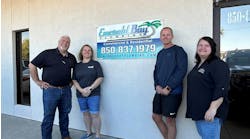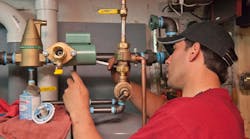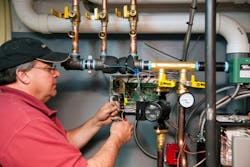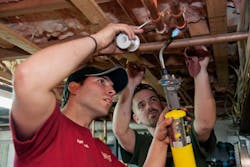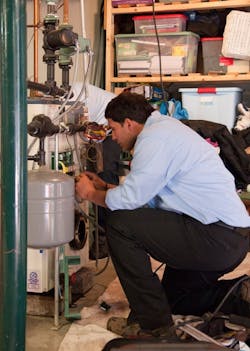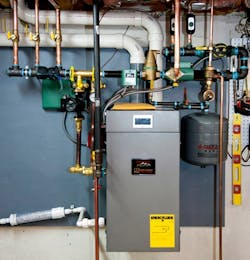WESTWOOD, MASS. — All along the East Coast, oil-fired hydronic heat has been the choice for many decades. In numbers not seen before, homeowners are making the switch to natural gas. Lower fuel cost, higher efficiencies and a preference for “home turf fuel” have all played a role.
Some homes are beyond the reach of gas utility lines, so switching simply isn’t an option. But for other New England residents, the gas lines are so close, they can taste the savings.
“In Fall 2011, the local water department began replacing the water mains in our neighborhood,” said Lincoln Kaiser, who lives in Westwood, Mass., with his wife and kids. “Realizing the road would be torn up anyway, I, along with several neighbors, approached NSTAR, the local gas utility, about extending the gas main while the road was under construction.
“NSTAR initially refused because not enough homeowners would commit to switching to natural gas heat,” he continued. “This would have resulted in our street being the only one in the whole neighborhood that didn’t have access to natural gas.”
At the time, the Kaiser home had a 15 year-old, oil-fired boiler and indirect tank to supply DHW. He soon inquired about getting the gas line extended so he could replace his system with new high-efficiency gas-fired equipment. The utility agreed to run the line down Kaiser’s street on the condition that he rally sufficient support among neighbors to make the switch to gas.
Not willing to give up easily, Kaiser and a couple other residents gathered the support needed. He and seven of his neighbors each agreed to pay the $1,000 security deposit required by the utility — to be paid back upon installation of a gas meter. The gas main was installed in November of 2012, and by late April this year, Kaiser and four neighbors had made the switch to gas heat and recouped their deposits.
According to Kaiser, he wanted the benefits of natural gas, but he wasn’t sure who to call to do the retrofit. He wasn’t sure his oil supplier, Needham Oil and Air, would be interested in the project.
“Needham has serviced our system since we bought the house in 2002, and we couldn’t be happier with them, but I was under the impression that they were primarily an oil company,” explained Kaiser. “So I put the job out to bid with another company before speaking with Needham. It turns out, Needham was interested, and actually came in with a lower bid, and a really cool idea to boot: because I was switching to an all-American fuel, would I consider doing the same with my heating equipment?”
Red, white and blue all over
“The prospect of having an entirely American “anything” today is pretty slim, and if you can find it, you’re going to pay top dollar,” added Kaiser. “So I was surprised to learn that it was an option for my mechanical room, so I was definitely interested. When I learned it wouldn’t cost more, I was really sold.”
Needham doesn’t focus exclusively on oil. Managers of the full-service HVAC company, which got its start in 1872 as a coal company, have no reservations about covering a broad spectrum of technologies. Today, Needham is still owned by the same family that started it nearly a century-and-a-half ago.
“We do commercial and residential work within 30 miles of our headquarters in Needham,” said Sales Manager Randy Golden. “The first residential, natural gas boiler we installed was about five years ago, and now we’re doing 40 gas retrofits each year.” But oil isn’t dead in New England. Three oil delivery trucks are still part of the Needham fleet, and their six install crews handle everything from custom sheet metal work to ductless systems and boiler installations.
As part of Kaiser’s all-American retrofit, the hydronic components used were manufactured roughly an hour’s drive away. Needham usually gets Taco equipment through The Portland Group.
“If Taco isn’t a local company, I don’t know what is,” said Golden. “They’ve supplied the highest quality components for years, and keep innovating to move technology and efficiency in the right direction. We put as much of that innovation into Kaiser’s system as we could.”
The boiler — a modulating, condensing Burnham Alpine — is also an American-made product. The system is manufactured about six hours away, in Pennsylvania, and also came through The Portland Group.
Deadline or cold showers
“The installation was picture perfect,” said Golden, days after the project completed in late May. “We weren’t constrained to a tiny mechanical closet, it wasn’t hard to get the old boiler out of the house, and the homeowner was easy to work with. The only difficulty was making sure we were done by the time the inspector arrived.”
The job started on a Monday morning. To get the gas meter installed, the jobsite needed to have a stamp of approval from the utility inspector, who could only make it to the site at 9:30 a.m. Tuesday. There wasn’t any time to spare once the old oil-burner was removed. And they didn’t want to miss the inspector’s visit; there’d be no telling when they could get heat into the home if they weren’t ready for him.
The four-bedroom, ranch-style house is 1,850-sq.ft. in size, but Kaiser plans to add a partial second story later this year. The current arrangement is two zones of three-quarter-inch fin-tube baseboard, plus DHW. Each zone activates through a ball-valve style Taco Zone Sentry valve. A 4900 air separator is used as part of the near-boiler piping to keep the system running quietly and efficiently.
“The job showcases new American technology,” said Golden. “That’s why we chose a Bumble Bee circulator and the mod-con boiler.” The Bumble Bee is Taco’s residential-sized ECM, variable speed circulator, which operates by the company’s signature Delta-T sensing method. The one pump handles both existing zones.
The 105 MBH, wall-hung Burnham Alpine supplies heat for an indirect tank as well as space heat for the home. With 95 AFUE and a five-to-one turndown, the American boiler is on a level playing field with similar European models but offers a few things others don’t.
“They gave me three boiler options that would all achieve the same comfort and efficiency, but the Burnham had the smallest price tag and also offered a free five-year warranty on parts and labor,” said Kaiser. “The other boilers didn’t have close to that.” A Taco 0015 is used as the boiler pump because the high pressure drop within a condensing boiler demands a powerful circulator.
Onward, upward
The home’s current heat load is 58,200 BTUs, but using Taco’s FloPro Designer software to calculate the additional load of the second story addition, the total load by next heating season will be 85,400. Unlike the original boiler, the Alpine is optimally sized for the home with the addition of DHW production.
Once the addition is complete, the Kaiser family will be able to enjoy more living space with a smaller utility bill, all the while knowing that the purchase of new mechanical equipment, and the money they spend on fuel, stays in the U.S.
“I’m glad the utility was willing to meet our request to run a line up our street,” said Kaiser. “With what looks like stability of long-term prices for natural gas, we’re very pleased with the way this all worked out.”
The home’s radiant installation will be featured in Part 2 of this article, which will appear online at www.Contractormag.comand in an upcoming issue of CONTRATOR magazine.
